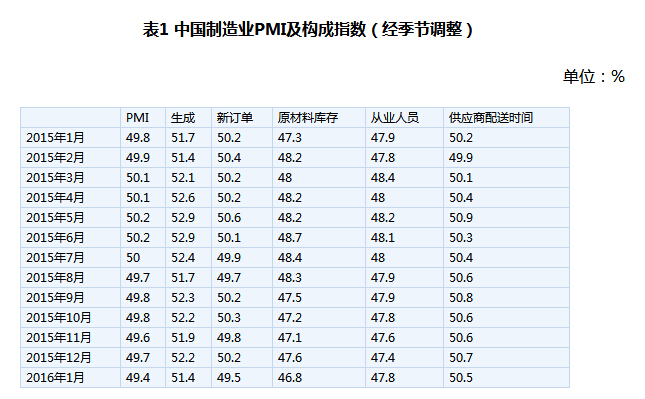Special analyst Zhang Liqun believes: "The PMI index in January dropped by 0.3 percentage points from the previous month, indicating that economic growth is still in a downward trend. The expected index of production and operation activities has declined slightly. The purchase volume index, raw material inventory index, import index, and finished goods inventory index There are different degrees of decline, indicating that the market expectation of the company's opening year is generally cautious. The new export order index declines, indicating that export difficulties are still relatively large. However, from the sub-industry index, the PMI index of seven industries, such as automobile and electrical machinery equipment manufacturing. More than 50%; the PMI index of seven industries such as food and paper printing increased from last month, indicating that positive factors of economic structural changes are gathering. Considering the further development of the effect of the previous stable growth policy, and the policies to be deployed this year. The expected effect is that the overall economic growth is expected to remain stable."
The production index was 51.4%, down 0.8 percentage points from the previous month. In terms of enterprise scale, the production index of large and medium-sized enterprises is higher than 50%, which is 52.6% and 51.2% respectively; for small enterprises, it is lower than 50%, which is 46.3%.
The new order index was 49.5%, down 0.7 percentage points from the previous month. In terms of enterprise scale, the new orders index of large enterprises is higher than 50%, which is 51.3%; medium-sized enterprises and small enterprises are less than 50%, which are 48.4% and 44% respectively.
The new export order index was 46.9%, down 0.6 percentage points from the previous month. In terms of enterprise scale, the new export orders index of large enterprises, medium-sized enterprises and small enterprises are all below 50%, which are 46.9%, 47.8% and 42.7% respectively.
The backlog index was 43.4%, down 0.2 percentage points from the previous month. In terms of enterprise scale, the backlog index of large enterprises, medium-sized enterprises and small enterprises is less than 50%, which are 44.9%, 42% and 39.4% respectively.
The finished goods inventory index was 44.6%, down 1.5 percentage points from the previous month. In terms of enterprise scale, the inventory index of finished products of large enterprises, medium-sized enterprises and small enterprises is less than 50%, which are 44.5%, 45.9% and 42.5% respectively.
The purchase volume index was 49%, down 1.3 percentage points from the previous month. From the perspective of enterprise scale, the large enterprise purchase volume index is higher than 50%, which is 50.6%; medium-sized enterprises and small enterprises are lower than 50%, which are 48.2% and 43.7% respectively.
The import index was 46.4%, down 1.2 percentage points from the previous month. In terms of enterprise scale, the import index of large enterprises, medium-sized enterprises and small enterprises are all below 50%, which are 46.4%, 46.3% and 47.9% respectively.
The purchase price index was 45.1%, up 2.7 percentage points from the previous month. In terms of enterprise scale, the purchase price indices of large enterprises, medium-sized enterprises and small enterprises are all below 50%, which are 44.2%, 46% and 47.8% respectively.
The raw material inventory index was 46.8%, down 0.8 percentage points from the previous month. In terms of enterprise scale, the raw material inventory indices of large enterprises, medium-sized enterprises and small enterprises are all below 50%, which are 47.5%, 46.7% and 43.4% respectively.
The employee index was 47.8%, up 0.4 percentage points from the previous month. In terms of company size, the index of employees in large, medium and small enterprises is less than 50%, which is 48.1%, 48% and 46.5% respectively.
The supplier's delivery time index was 50.5%, down 0.2 percentage points from the previous month. In terms of enterprise scale, the distribution time index of suppliers of large and medium-sized enterprises is higher than 50%, which is 50.7% and 50.6%, respectively, and that for small enterprises is less than 50%, which is 49.1%.
The expected index of production and operation activities was 44.4%, down 0.2 percentage points from the previous month. In terms of enterprise scale, the expected indices of production and operation activities of large, medium and small enterprises are all below 50%, which are 45.6%, 43.5% and 40.8% respectively.


We diviided the led light according to the using eviiroment. Most of our product is the commercial LED Lighting
Commercial lighting is a term used to describe lighting that is used in commercial spaces, including auto dealerships, distribution centers, churches, factories, offices, and warehouses. Unlike residential lighting, commercial lighting is made to withstand more abuse and has a longer lifespan.
While the focus of residential lighting is often on aesthetics, commercial lighting is task orientated. Commercial lighting systems are designed based on what the application is. For example, in an office-type setting, you may see task lighting, which illuminates specific areas where employees need concentrated light to be able to perform their jobs.
Suspend Linear Light,Linear Wall Sconce Lighting,Linear Wall Mounted Light Fixture,Linear Lights For Kitchen
Jiangmen Dilin Lighting High-Tech Co., Ltd. , https://www.jmdilinlight.com
![<?echo $_SERVER['SERVER_NAME'];?>](/template/twentyseventeen/skin/images/header.jpg)